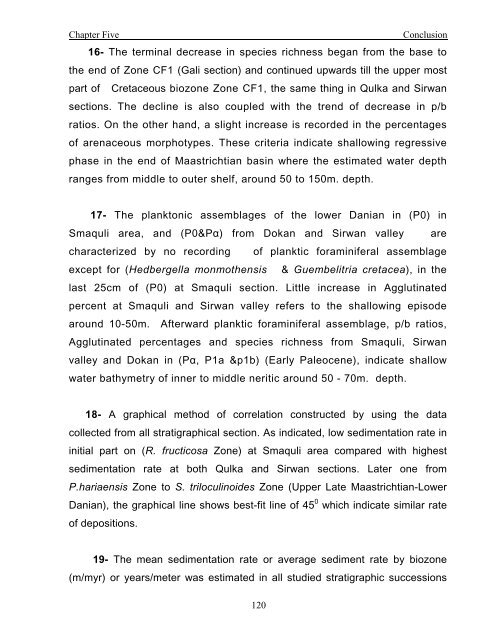biostratigraphy and paleoecology of cretaceous/tertiary boundary in ...
biostratigraphy and paleoecology of cretaceous/tertiary boundary in ...
biostratigraphy and paleoecology of cretaceous/tertiary boundary in ...
You also want an ePaper? Increase the reach of your titles
YUMPU automatically turns print PDFs into web optimized ePapers that Google loves.
Chapter Five<br />
Conclusion<br />
16- The term<strong>in</strong>al decrease <strong>in</strong> species richness began from the base to<br />
the end <strong>of</strong> Zone CF1 (Gali section) <strong>and</strong> cont<strong>in</strong>ued upwards till the upper most<br />
part <strong>of</strong> Cretaceous biozone Zone CF1, the same th<strong>in</strong>g <strong>in</strong> Qulka <strong>and</strong> Sirwan<br />
sections. The decl<strong>in</strong>e is also coupled with the trend <strong>of</strong> decrease <strong>in</strong> p/b<br />
ratios. On the other h<strong>and</strong>, a slight <strong>in</strong>crease is recorded <strong>in</strong> the percentages<br />
<strong>of</strong> arenaceous morphotypes. These criteria <strong>in</strong>dicate shallow<strong>in</strong>g regressive<br />
phase <strong>in</strong> the end <strong>of</strong> Maastrichtian bas<strong>in</strong> where the estimated water depth<br />
ranges from middle to outer shelf, around 50 to 150m. depth.<br />
17- The planktonic assemblages <strong>of</strong> the lower Danian <strong>in</strong> (P0) <strong>in</strong><br />
Smaquli area, <strong>and</strong> (P0&Pá) from Dokan <strong>and</strong> Sirwan valley are<br />
characterized by no record<strong>in</strong>g <strong>of</strong> planktic foram<strong>in</strong>iferal assemblage<br />
except for (Hedbergella monmothensis & Guembelitria cretacea), <strong>in</strong> the<br />
last 25cm <strong>of</strong> (P0) at Smaquli section. Little <strong>in</strong>crease <strong>in</strong> Agglut<strong>in</strong>ated<br />
percent at Smaquli <strong>and</strong> Sirwan valley refers to the shallow<strong>in</strong>g episode<br />
around 10-50m. Afterward planktic foram<strong>in</strong>iferal assemblage, p/b ratios,<br />
Agglut<strong>in</strong>ated percentages <strong>and</strong> species richness from Smaquli, Sirwan<br />
valley <strong>and</strong> Dokan <strong>in</strong> (Pá, P1a &p1b) (Early Paleocene), <strong>in</strong>dicate shallow<br />
water bathymetry <strong>of</strong> <strong>in</strong>ner to middle neritic around 50 - 70m. depth.<br />
18- A graphical method <strong>of</strong> correlation constructed by us<strong>in</strong>g the data<br />
collected from all stratigraphical section. As <strong>in</strong>dicated, low sedimentation rate <strong>in</strong><br />
<strong>in</strong>itial part on (R. fructicosa Zone) at Smaquli area compared with highest<br />
sedimentation rate at both Qulka <strong>and</strong> Sirwan sections. Later one from<br />
P.hariaensis Zone to S. trilocul<strong>in</strong>oides Zone (Upper Late Maastrichtian-Lower<br />
Danian), the graphical l<strong>in</strong>e shows best-fit l<strong>in</strong>e <strong>of</strong> 45 0 which <strong>in</strong>dicate similar rate<br />
<strong>of</strong> depositions.<br />
19- The mean sedimentation rate or average sediment rate by biozone<br />
(m/myr) or years/meter was estimated <strong>in</strong> all studied stratigraphic successions<br />
120

















